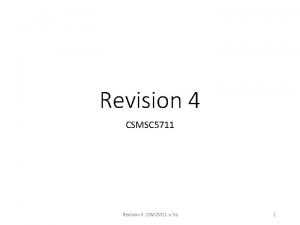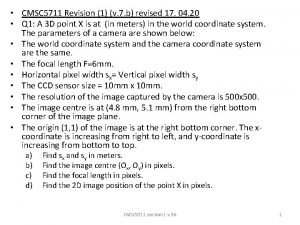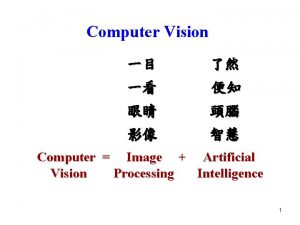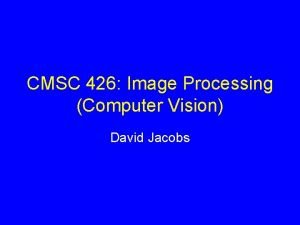CMSC 5711 Image processing and computer vision Revision








- Slides: 8

CMSC 5711 Image processing and computer vision Revision 2 CMSC 5711 Revision 1 V. x 56. 7 b 1

Q 2. 1 • • A 3 D point M is at [X, Y, Z]T=[0. 2, 0. 1, 2. 0] T (in meters) in the world coordinate system. The parameters of a camera are shown below: The focal length F=3 mm. Horizontal pixel width sx= Vertical pixel width sy=5 m. The CCD sensor size = 10 mm x 10 mm. The image centre is at the centre of the image plane. The origin (1, 1) of the image is at the right-bottom corner. The x-coordinate is increasing from right to left, and y-coordinate is increasing from bottom to top. You may assume the camera coordinates are the same as the world coordinates. a) Estimate the size (Xmax, Ymax) of the image captured by the camera in pixels. b) Estimate the image centre (Ox, Oy) in pixels measuring from the right-bottom corner of the CCD sensor. c) Find the focal length in pixels. d) Find the 3 -D position of the point M in pixels. e) M is being translated by T= [1, 2, 3]T meters first and then rotated around a point P=[1. 5, 2. 0, 5. 5] T, the rotation angles are [ 1 , 2 , 3 ]=[0. 1, 0. 2, 0. 3] in degrees. Find the new 3 -D position (M’) of M in pixels. f) Find the 2 -D image position (in pixels) of M’. CMSC 5711 Revision 1 V. x 56. 7 b 2

Q 2. 2 • Convolution , edge mask and edge detection • An image S and a mask m are shown below • a) Find the convolution result of S and m, the result should include all partially overlapping cases. b) Show the matrix of a 3 x 3 second order edge mask that you know. c) How do you find an edge image using a second order edge mask? CMSC 5711 Revision 1 V. x 56. 7 b 3

• An original gray level image has resolution M=50 rows and N=50 columns. The gray level resolution (L) of each pixel is 8 (gray level from 0 to 7). R(k) is the gray level of index k, N(k) is the number of pixels that have gray level R(k). Pr(R(k)) is the probability of the pixels in the image having gray level R(k). After histogram normalization, S(k) is the normalized gray level of index k. A table to help you to perform histogram equalization is shown below. a) Find the value of x in the table. b) Discuss the relation between pixel resolution (bits per pixel) and the result of histogram normalization in image processing. c) For the following table (you may copy it to your answer book first), fill in the blanks. d) Discuss how to use histogram equalization to make a colour picture looks better. Q 2. 3 r(k) N(k) Pr(r(k)) r(0) 13 r(1) 46 r(2) 285 r(3) 645 r(4) 777 r(5) 490 r(6) 91 r(7) x CMSC 5711 Revision 1 V. x 56. 7 b S(k) Round off (S(k)) 4

Q 2. 4 • Structure from motion • Initially at time = 0, the centre of all (total four, index j=1, 2, 3, 4) image feature points of an object is at [0, 0]T. At time =t, the object is moved to a new position and the projected image points x(j, t) (in pixels) are at – x(j=1, t)=(a, b) – x(j=2, t)=(c, d) – x(j=3, t)=(e, f) – x(j=4, t)=(g, h) – (a) If an orthographic camera model is used, calculate the image translation of the object from time =0 to time =t in terms of a, b, c, d, e, f, g and h. • – (b) The projection matrix of a camera is of size 3 by 4. Discuss the constraints for the values in the projection matrix for each of the following camera models : • A perspective camera. • An affine camera. • An orthographic camera. • – (c) Discuss the relative advantage and disadvantages of using (i) factorization and (ii) bundle adjustment for finding the structure and pose of an object from an image sequence. You may comment on their speeds, accuracies and the types of approaches (linear or iterative) etc. CMSC 5711 Revision 1 V. x 56. 7 b 5

• • • As shown above, the image of an object has pixels of gray level with intensity from 0 to 5. Empty cells in the image represent that the pixel has intensity 0. A mean shift algorithm is applied to find the position of the object of size approximately 5 x 5 pixels. That means you need to find the centre of a 5 x 5 window best covering the object. The initial window is centred at (x, y)=(4, 6) as shown above. a) Find the location of the centre of the 5 x 5 search window at each step of the mean-shift algorithm. Show your calculation steps and round off numbers to integers during your calculations. b) What would happen if the initial search window is centred at (12, 4). Q. 2. 5 0 1 2 3 4 5 6 7 8 9 10 11 12 13 14 1 2 3 4 5 6 7 8 9 10 1 1 1 2 1 3 1 1 1 4 1 1 1 1 5 11 12 CMSC 5711 Revision 1 V. x 56. 7 b 6

Q 2. 6 • CMSC 5711 Revision 1 V. x 56. 7 b 7

Q 2. 6 (continue) • CMSC 5711 Revision 1 V. x 56. 7 b 8















